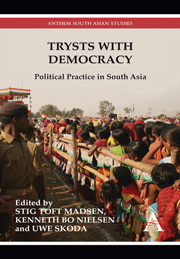Book contents
- Frontmatter
- Contents
- List of Tables
- List of Abbreviations
- Glossary
- Map of South Asia
- Acknowledgements
- 1 Introduction
- Part One Theoretical Issues
- Part Two India
- Part Three Beyond India
- 8 Nepal: Governance and Democracy in a Frail State
- 9 Entanglements of Politics and Education in Sri Lanka
- 10 Shifting between the Local and Transnational: Space, Power and Politics in War-torn Sri Lanka
- 11 Domestic Roots of Indian Foreign Policy
- 12 When Democracy is Not the Only Game in Town: Sectarian Conflicts in Pakistan
- About the Editors
- About the Contributors
11 - Domestic Roots of Indian Foreign Policy
from Part Three - Beyond India
Published online by Cambridge University Press: 05 March 2012
- Frontmatter
- Contents
- List of Tables
- List of Abbreviations
- Glossary
- Map of South Asia
- Acknowledgements
- 1 Introduction
- Part One Theoretical Issues
- Part Two India
- Part Three Beyond India
- 8 Nepal: Governance and Democracy in a Frail State
- 9 Entanglements of Politics and Education in Sri Lanka
- 10 Shifting between the Local and Transnational: Space, Power and Politics in War-torn Sri Lanka
- 11 Domestic Roots of Indian Foreign Policy
- 12 When Democracy is Not the Only Game in Town: Sectarian Conflicts in Pakistan
- About the Editors
- About the Contributors
Summary
Introduction
Domestic politics are playing an increasingly important role in the shaping of Indian foreign policy just as India is poised to play a more important role in world politics. This is a relatively new phenomenon and the consequences for Indian foreign policy are not yet clear. Until the late 1980s, foreign policy was largely the prerogative of the executive – as exercised by the Prime Minister directly through the Ministry of External Affairs – and was relatively autonomous from domestic politics. While elections and politics in India seldom revolve around foreign policy issues, the content of foreign policy is no longer insulated from domestic politics when the interests of important groups are involved. Foreign and security policy-making, however, are still centralized in the Prime Minister's Office (PMO) and parliament does not have veto power over foreign policy initiatives, such as treaties. The PMO has the added advantage in its dealings with parliament in its access to expert opinions not available to members of parliament. Despite this structural advantage, the growing importance of public opinion connects to the formulation of policy, which will be analyzed below. In the context of levels of analysis, this piece focuses on the state unit and we will only marginally analyze the influence of the international system on foreign policy, specific decision makers or intrabureaucratic negotiations.
- Type
- Chapter
- Information
- Trysts with DemocracyPolitical Practice in South Asia, pp. 261 - 280Publisher: Anthem PressPrint publication year: 2011
- 3
- Cited by



